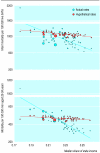Relation between income inequality and mortality: empirical demonstration
- PMID: 10514157
- PMCID: PMC28248
- DOI: 10.1136/bmj.319.7215.953
Relation between income inequality and mortality: empirical demonstration
Abstract
Objective: To assess the extent to which observed associations at population level between income inequality and mortality are statistical artefacts.
Design: Indirect "what if" simulation by using observed risks of mortality at individual level as a function of income to construct hypothetical state level mortality specific for age and sex as if the statistical artefact argument were 100% correct.
Setting: Data from the 1990 census for the 50 US states plus Washington, DC, were used for population distributions by age, sex, state, and income range; data disaggregated by age, sex, and state from the Centers for Disease Control and Prevention were used for mortality; and regressions from the national longitudinal mortality study were used for the individual level relation between income and risk of mortality.
Results: Hypothetical mortality, while correlated with inequality (as implied by the logic of the statistical artefact argument), showed a weaker association with states' levels of income inequality than the observed mortality.
Conclusions: The observed associations in the United States at the state level between income inequality and mortality cannot be entirely or substantially explained as statistical artefacts of an underlying individual level relation between income and mortality. There remains an important association between income inequality and mortality at state level over and above anything that could be accounted for by any statistical artefact. This result reinforces the need to consider a broad range of factors, including the social milieu, as fundamental determinants of health.
PIP: The aim of this study is to evaluate the extent to which observed associations at the population level between income inequality and mortality are statistical artifacts. Data from the 1990 census for the 50 American states plus the District of Columbia were used for population distributions by age, sex, state and income range; data disaggregated by age, sex and state from the Centers for Disease Control and Prevention were used for mortality; and regressions from the national longitudinal mortality study were used for the individual level relation between income and risk of mortality. Results revealed that hypothetical mortality, while correlated with inequality, displayed a weaker association with state's levels of income inequality than the observed mortality. The associations seen in the US at the state level between income inequality and mortality cannot be entirely or substantially explained as statistical artifacts of an underlying individual level relation between income and mortality. There is still a significant association between income inequality and mortality at state level over and above anything that could be accounted for by any statistical artifact. This finding reinforces the need to consider a broad range of factors, including the social milieu, as fundamental determinants of health.
Figures


Comment in
-
Diminishing returns to aggregate level studies.BMJ. 1999 Oct 9;319(7215):955-6. BMJ. 1999. PMID: 10576845
-
Two pathways, but how much do they diverge?BMJ. 1999 Oct 9;319(7215):956-7. BMJ. 1999. PMID: 10576846
References
-
- Wilkinson RG. Unhealthy societies: the afflictions of inequality. London: Routledge; 1996.
Publication types
MeSH terms
LinkOut - more resources
Full Text Sources
